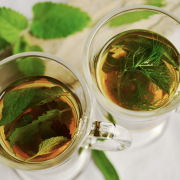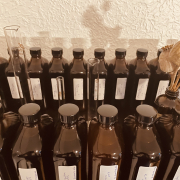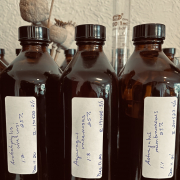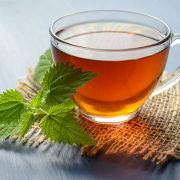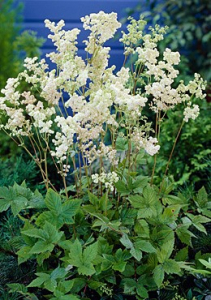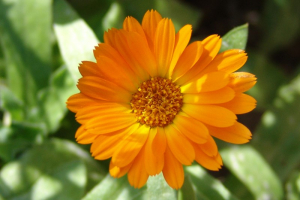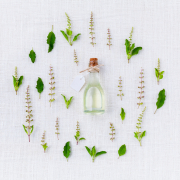Herb Medicine “Battery” an Uplifting Nervine for Children and Adults a-like by David Shaw – Medical Herbalist; c.N.C.
Herbal Medicine Battery! This blend gets its name from its uplifting and nourishing actions. The formula helps give energy while encouraging the body to rest. We have used this blend with a few different patients: including children as young as three and adults in their sixties. While not every herb is right for children; Lemon Balm, Ashwagandha and Chamomile are some of the best to use! Each formula will have a different ratio of herbs depending on what the individual is looking for. When talking with a person that is having more digestive upset the blend will have more Chamomile and Lemon Balm in it because of their affinity to the digestive system. If the primary focus is to support stress and anxiety the blend might be heavier in Ashwagandha. One of the greatest benefits of taking some time to talk with a medical herbalist is that your formula is tailored specific to your health goals. Even spending 15 minutes with a medical herbalist can shed some light on information that might help them make slight adjustments to your formula. Sometimes it is beneficial to do a more in-depth consultation. This is often recommended for people who have chronic or more complex conditions.

Chamomile (Chamomilla recutita):
Probably one of the most underrated digestive herbs in the herbal medicine cabinet, Chamomile is known as “the mother of the gut,” and for good reasons! The constituents in this plant help with a wide range of digestive complaints from dyspepsia (which is a sickly feeling associated with nausea) all the way to reducing inflammation in the digestive tract. Chamomile also has a nice calming effect to the nervous system though it is subtle. This subtle relaxing effect may not be as noticeable in the adults but with children it is quite effective. Chamomile is also known for its anti-allergic properties and is often put in topical blends to help with eczema and herbal tincture formulas to help with seasonal allergies.
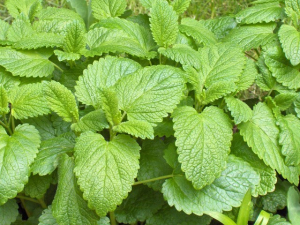
Lemon Balm (Melissa off.):
Lemon Balm is a very bright plant. If you have ever tasted a fresh tincture extract of this plant you can be instantaneously launched in to a feeling of brightness. The zing you get from the lemon taste comes from the volatile oils in the plant. This is often why herbalist lean towards fresh plant extractions as the plant will have a higher concentration of these constituents.
Beyond Lemon Balm’s uplifting nervous system support it also has uses for digestive complaints. Lemon Balm like many other mint-family (Lamiaceae) plants has antispasmodic properties in the intestine helping to relax spasms as well as help with gas and bloating. Another major benefit from fresh plant extracts is the well-known research of the anti-viral properties Lemon Balm offers. More specifically herbalists use this plant as a topical to help with herpes simplex (HSV1 &2).
There are cautions around using this plant with people who have Hypothyroid. Speak with a Medical Herbalist for more information.
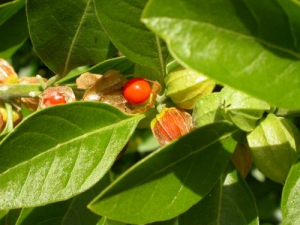
Ashwagandha (Withania somnifera):
This plant is quite easily one of the favourites taken and used at Errant Empire. The versatility of this plant as well as the safety profile makes this plant applicable to children and elders alike. Ashwagandha gets its common name from an interesting association with the smell of horsehair. The idea behind this is the fresh roots when unearthed smell like a sweaty horse. At Errant Empire Herbal Medicine Dispensary, we quite often carry stronger extracts of this plant. We are able to achieve higher doses with patients with these stronger 1:1 or 1:2 extracts. *If you are interested to learn about the strengths of herbal tincture please go see our other blog here.*
We use Ashwagandha for everything from adrenal and nervous system support to sleep and inflammatory conditions. This plant is also well known for its anabolic properties helping athletes achieve their goals. This is one of the many adaptogens in the herbal medicine dispensary that is helpful in increasing athletic performance. We blend this plant with other anti-inflammatory herbs to help with inflammatory conditions like Rheumatoid Arthritis (RA) and Osteoarthritis (OA). We also use this plant to stimulate thyroid function in people who have hypothyroidism. It is important to speak with an herbalist to see if this is the right herb for your hypothyroidism as it’s not applicable across the board and maybe less beneficial than other herbs. With that in mind, this plant is contraindicated for people with hyperthyroid function.
15-minute herbal consultation:
These are some of our favourite herbs at Errant Empire because of their safety profile and for the results, we see with people using these plants. Charge your battery for spring with this blend! There’s so much to gain from speaking to a medical herbalist. We are grateful to be able to offer a free 15-minute consultation to make sure that these plants are right for you. We have a basic intake form so that we can cover specific health information like your current medications and supplements. We also have specific questions we ask to find out underlying causes for conditions.
Please don’t hesitate to reach out if you have any questions about which plants to use or if you want to design a custom herbal formula. We are the leading online herbal medicine dispensary that is meeting the world where it’s at. We want to bring the experience of going to an herbal medicine dispensary to the online world. You can contact us directly through email or phone. We can set up a time to do a Skype call or book a full consultation. It’s up to you.
Patreon:
We utilize Patreon as a membership platform to offer discounts and better rates to people who use herbal medicine regularly. Please check out our Patreon page and see if one of these plans is right for you. With our entry-level membership, you are able to get upwards of 36% off individual tincture purchases and 15% off custom formulas. We also offer a higher-tiered membership for people who are going to have regular consultations: that also includes a two-week formula for free.
I hope you are well and thank you for reading this blog I look forward to starting the conversation with you.
David Shaw – Medical Herbalist; c.N.C. herbalist@errantherbal.com
250.686.4647
www.errantempireherbalmedicine.com
Patreon:
_________________________________________________________
1 – (Vogl H, Tausch I, Wolbling R H and Kaiser PM)
